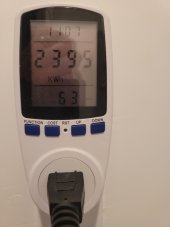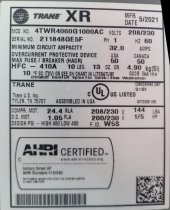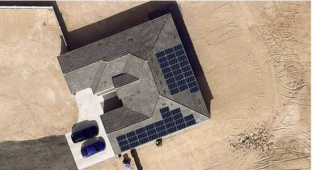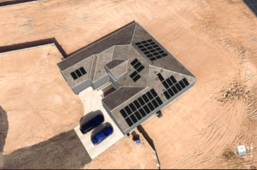Thank you for the well thought out response. While I understand my new home is using less power (about half?) I would like to build the solar array for future use as well, hence the larger system.Based on your numbers...
14205 kWh / 264 days = 53.8 kWh/day
53.8 kWh/day * 365 days/year = 19640 kWh/year
53.8 kWh/day / 24 h/day = 2.24 kW
So your yearly consumption is about 20000 kWh per year and your current average load is about 2.25 kW.
Assuming you get on average around 8 hours of full sunlight a day every day of the year, you will need a solar array of 3 * 2.25 kW = 6.75 kW minimum to cover your current usage. Make that 8 kW just to be sure (20 panels).
An average mini split uses 600 watts/hour. Two of them will add 1.2 kW/h.
An EV requires huge power in the range of 50 - 100 kW per full charge (real world is around 75 kW maximum). Assuming the maximum and fully charging every day, you will require 100 kW in 8 hours of full sunlight. That's 12.5 kW per hour. So you would need 8 kW + 1.2 kW + 12.5 kW = 22 kW of solar power every day to run everything. The would require 55 x 400 watt panels or 54 x 410 panels.
Your number of panels is in the same ball park, but it seems like a large system. The EV would require more than half the system, and the size and complexity is high for a first time DIY system. Without the EV you would be down in the 10 kW range which still seems a little large for a 2500 square foot house. Do you plan to install 55 panels on your roof? Is there room?
You also need to work out the deal with micro, grid-tie, string, and hybrid inverters. Since you haven't provide information on how you plan to put it all together, I suspect that you don't know yet, and may not understand the purpose and differences between them. You need to decide how you are going to connect the PV system to the grid or the inverter. I think it might be good to consider a string inverter configuration unless you have shading or angle issues on your roof.
Batteries are rated in amp hours. So you need to convert your power needs from kWh to amp hours to determine how large of a system you will need and how much it will cost. Lead acid batteries typically range from 200 - 400 amp hours each @ 12VDC. Lithium (LiFePO4) typically range from 100 - 300 Ah @ 3.65VDC. Your inverter will probably require 48VDC. Assuming 12V lead acid batteries (50% discharge), to get near 40 kWh of usable power, you will need 2 x 4 x 200Ah x 4 = 32 deep cycle batteries. Lithium will require four times the number of cells, so a total of 128 cells. Both would provide 800 Ah @ 48VDC. That is a fairly large battery. It would run your house for a few hours. Although it is fairly large, you have to remember that the EV needs 50 - 80 kW per charge, so a 40 kWh battery won't be able to fully charge the EV every day. If you really are planning to charge an EV with the system, you will need to feed the grid all day long and then use the grid to charge the EV. You will still pay for electricity. If you use the battery, you won't be able to store enough to do a full charge, and you will wear the battery out.
Sol-Ark is probably the most expensive option out there. Maybe I would buy them if there price wasn't three times the alternative. You should look at alternatives unless you have plenty of money. Maybe consider scaling back the system for now.
Your month of August number comes out to an average load of 6.62 kW all day and night for 30 days straight. That is 3 times as high as your current rate of consumption. You must have had central air running non stop for a month in 115 degree temperature.
Before you buy anything you need to do your own calculations to make sure its all correct.
Based on your numbers, (I still need to validate on my end), it seems the size system is a good match?









